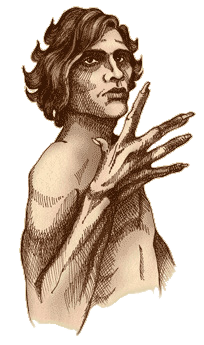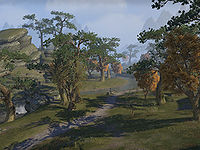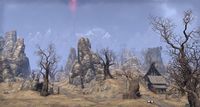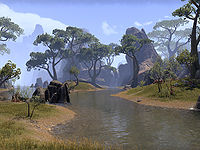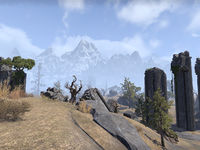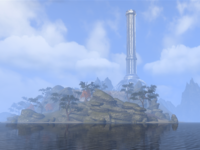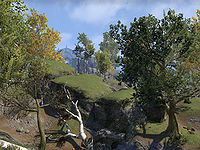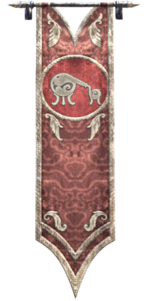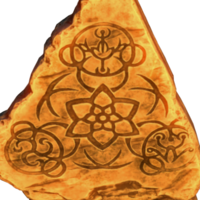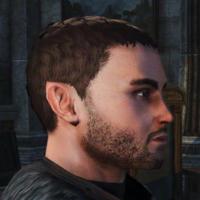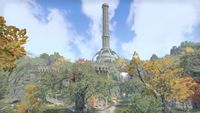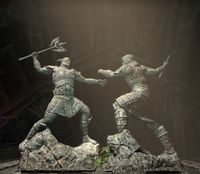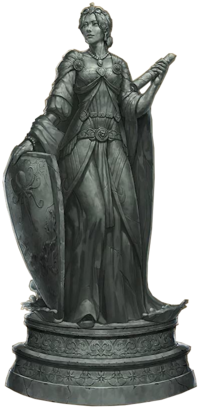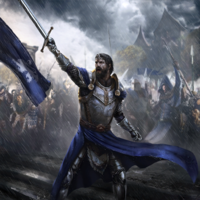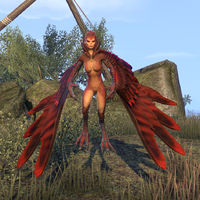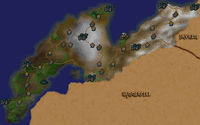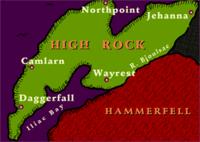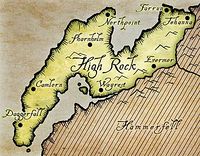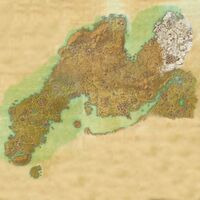Lore:High Rock
| This page is currently being redesigned for the Lore Places Project (LPP). The page may need work to meet the standards outlined on the project page. |
| This page or parts of this page were previously transcluded to other pages per this discussion. This page should be checked for potential unrelated lore and other information. Please remove this banner when the page has been cleaned up. |
| High Rock | |
|---|---|
| Type | Province |
| Continent | Tamriel |
| Appears in | Arena, Daggerfall, Shadowkey, ESO, Legends |
High Rock is a province in northwestern Tamriel. Most of the province is inhabited by the Bretons, who have divided the province into multiple Breton city states and minor kingdoms. High Rock has also historically contained Orsinium, the City-State of the Orcs. High Rock encompasses the many lands and clans of Greater Bretony, the Dellese Isles, the Bjoulsae River tribes, and, by tradition, the Western Reach.[1] The Direnni once controlled the entire province until the dissolution of their Hegemony in the First Era, leaving behind many ruins and a lasting legacy on the newly formed Breton city-states in their wake.[2] The rugged highland strongholds and isolated valley settlements have encouraged the fierce independence of the various local Breton clans, resisting integration into a formal province or Imperial identity. Nonetheless, their language, bardic traditions, and heroic legends are a unifying legacy. Aside from the Bretons and their ancestors, other races that have inhabited the province include centaurs, giants, goblins, Orcs, and Snow Elves.[3][UOL 1]
Geography[edit]
High Rock borders Hammerfell across the Bangkorai Pass to the southeast and Skyrim across the Druadach Mountains to the east. Its landscape is diverse. Some examples of its range include tropical islands,[4] temperate forests, windy crags, badlands, highlands, snowy mountains, and isolated valleys.[5]
High Rock consists of six main regions: Glenumbra, Stormhaven, Rivenspire, the Western Reach, northern Bangkorai and Wrothgar. In addition, the islands of Balfiera, Betony, Caecilly, Craghold, Dellese, and Sword's Rest are also a part of High Rock.[6] At times, the Systres have been considered a Duchy of High Rock.[7] The High Rock Sea Coast is an officially recognized region in the Iliac Bay that was left unconquered until the Warp in the West occurred in 3E 417.[8] The islands of Grayhome, Herne, and Kevalla are also found close to High Rock.
Glenumbra[edit]
Glenumbra is the westernmost region of High Rock, encompassing most of the large peninsula separating the Iliac Bay from the Eltheric Ocean. It borders Stormhaven to the northeast and Rivenspire across the King's Guard Mountains to the north. The region contains the city-states of Daggerfall and Camlorn, as well as the great cemetery of Cath Bedraud. The ancient battlefield of Glenumbra Moors, where the Direnni defeated the Alessian Horde, is also located here. The southern forests of Glenumbra are home to several witch covens, like the Beldama Wyrd and the Glenmoril Wyrd.[9]
The region consists mostly of rolling green hills and forests; there is also a sizable swamp around the area of Hag Fen, to the southeast of Camlorn.[6]
Stormhaven[edit]
Stormhaven is the central region of High Rock, situated at the mouth of the Bjoulsae River. It borders Glenumbra to the west, Rivenspire to the northwest, Wrothgar to the north, and Bangkorai to the east. Stormhaven is comprised of three regions: Alcaire, Menevia, and Gavaudon. The landscape consists of rolling hills, lush flood plains, rocky outcrops, and ancient woodlands.[10]
Alcaire lies in the west, and is the celebrated birthplace of Tiber Septim.[11] Farmers and fishing villages thrive off the clement conditions of the Iliac Bay which grant them their bounty of fish and crops. Zenithar is commonly worshipped here. Alcaire's hamlets swear allegiance to the Knights of the Flame, which are housed in Alcaire Castle.[10]
Menevia spans the center of Stormhaven, and is home to the great trading port city of Wayrest. In the Second Era, Wayrest was home to the Cumberland merchant clan, which gained immense wealth after their orichalcum mining operations proved lucrative, and eventually took up the throne.[10]
The fiefdom of Gavaudon lies in the east. Rich, alluvial soil lies in the flood plains around the mouth of the Bjoulsae River. The frontier farmers who reap the soil's bounty are hardy and willing to withstand the region's inclement weather. Gavaudon was a common point of interest for Orc raiders coming from the Wrothgarian Mountains in the Second Era until the Daggerfall Covenant was formed.[10]
Rivenspire[edit]
Rivenspire is the northern area of High Rock. It borders Glenumbra across the King's Guard Mountains to the southwest, Stormhaven to the south, and Wrothgar to the southeast. The region contains the city-states of Shornhelm and Northpoint and the infamous Crypt of Hearts. It also contained the Doomcrag, a massive Ayleid tower, before it was destroyed in 2E 582.
The region's landscape is rather gloomy and consists of dry badlands, with jagged rock formations, flinty crags, windswept moors, and narrow canyons.[6]
Bangkorai[edit]
The two regions of northern Bangkorai, Mournoth and Ephesus, make up the southeastern reaches of High Rock. The region borders Wrothgar to the north, The Reach in Skyrim and Craglorn in Hammerfell to the east, and the Fallen Wastes of Hammerfell, which make up the southern Bangkorai, to the south. The main settlement is the city of Evermore. The region is home to the Bangkorai Pass, a fortified garrison which serves as High Rock's protection against the raiders from Hammerfell. Another notable location is the Halcyon Lake, where the ruins of Bisnensel, a city founded by the last Ayleid king Laloriaran Dynar, are located.
The region consists of forested uplands.[6]
Wrothgar[edit]
Wrothgar is an independent Orcish kingdom that existed in the northeastern region of High Rock during the Second Era.[12]. It borders Rivenspire to the west, Stormhaven to the south, the Skyrim holds Haafingar and the Reach to the east and Bangkorai to the southeast. The region is home to the great Orcish city of Orsinium, located in the Wrothgarian Mountains, as well as the Breton city of Farrun (formerly the Orcish Fharun) and the city of Jehanna. It also contains numerous Orc strongholds and Dwemer ruins. The great mountain of Sorrow can be found in the extreme northeast, on the border with Haafingar.
The region's climate is harsh; the landscape consists of boreal forests, tundras and snowy mountains.[6]
Isle of Balfiera[edit]
The isle of Balfiera is situated in the middle of the Iliac Bay. It is renowned as the site of the Direnni Tower, also known as Adamantine Tower, which is the oldest known building in Tamriel.[13]
Betony[edit]
The green and forested isle of Betony is situated to the south of Glenumbra. In the Second Era the island was conquered by the Stonetooth Orcs, who renamed it Betnikh. Eventually the island was reclaimed by the Bretons. The island is well known for triggering the War of Betony in 3E 403.[6][14]
History[edit]
Early History[edit]
It can be rightly said that history begins in High Rock. Convention occurred here, at Adamantine Tower, the oldest structure in existence. The tower was there when Aldmer settled the region and inspired almost every race of mer to create a mimicry of it.[15] High Rock's modern history can be drawn around the Breton, a race which originated from Nedes and Aldmer interbreeding[16] for centuries by the early First Era.[17] Bretons originated from Nedes and Aldmer interbreeding[16] for centuries as far back as the Merethic Era.[18][17] Whether Man or Mer came to High Rock first is debated in scholarly circles: some believe that Nedic civilization and their Druid King were already established in the province when the Aldmer arrived,[18] while others claim that the Nedes arrived in High Rock afterwards, and encountered the elves gradually with a variety of reactions and outcomes.[19][2][UOL 1] There's also evidence that a beastfolk population were High Rock's original inhabitants, though they did not build permanent communities, and what interactions they had with Men and Mer are unknown.[20]
The Nedic ancestors of the Bretons were a people that survived in ancient High Rock by tapping into and nurturing nature.[21][22] They followed Y'ffre's True Way (later known as Druidism),[23] in which the eponymous god took the forefront of their faith. Under it, one is to lead a life connecting with and valuing the natural world.[24] Some reverence was also shown to the stars, especially the Ritual constellation.[22] These Nedes are known by the retroactive nomenclature, the Druids of Galen,[18][17][25][26] (or proto-Bretons)[UOL 2][21] and what would become their moniker is derived from a mythical "Galen", an entity or place which druids first came about.[21] Regardless of the origin, it is agreed that the True Way was born in High Rock.[27]
There is evidence of human settlements in High Rock dating back at least a thousand years before recorded history.[28] Archaeological excavations have dated the ruins of Nedic habitation to as early as ME 1000, predating Ysgramor by centuries.[19] The Nedes of Stormhaven had strained relations with the neighboring Orc clans, which regularly clashed with other Orc clans and their Nedic neighbors.[29]
The Aldmer that settled High Rock did so sparsely and in very specific locations, the most successful being Clan Direnni,[2] who came to the province from the Summerset Isles in the Middle Merethic Era and captured the Adamantine Tower.[30][31] Some believe the Direnni were following their destiny to rule from Balfiera, while others believed that they were exiled.[32] The Direnni didn't enslave the Nedes as the Ayleids of Cyrodiil did; instead, they ruled them as a noble caste. The elves established a system of feudal vassalage over their new subjects and took Nedic concubines.[33][31] They inevitably interbred with their human subjects, producing Half-Elven children (also known as Manmer).[33][20]
The Direnni, Druids, and the Wyrd[edit]
The Druids of Galen led the new race when it first emerged,[UOL 3] as children begat from Elf-Nede relations were considered sub-Mer and not accepted by their Direnni parents. Instead, they were given privileged positions among the Nedes, which eventually led to a recognizable mixed-blood human caste dubbed "Bretons", from the Ehlnofex "beratu", meaning "half".[18][33] These Bretons were only allowed to marry humans, and over time, the Bretons' human features became more prominent than their elven traits.[33] Druids believe in Manmer's ability to enhance or perfect nature.[34] Indeed, shortly after the Breton race came into existence, Druidic spellcraft became the first truly Breton creation, and "druid" as a distinct identity would emerge.[22][35]
Eventually, the Wyrd diverged from the True Way in a religious schism, ultimately driven away by what they called the "excesses of the Elves".[22] In druidic belief, mortals[22] were not meant to separate themselves from nature, as one can rejuvenate and enjoy Y'ffre's bounty through it.[36][37] While the druids revere nature, they were not keen to isolate themselves and worship the untamed wilds.[22][38] Therein lies the primary difference in culture between druids and the Wyrd: the Wyrd abandoned civilization in favor of living in the wilds,[22] and believe that they are nature itself: the forest, the plants and beasts within it, and even the weather.[39][22] In contrast, druids accepted what they interpreted as their "proper place" as people, and embraced the idea that civilization can coexist alongside nature.[22][38][37][40] The Druids of Galen and the Wyrd disapproved of each other's lifestyles: the druids found the ways of the Wyrd unsavory, and the Wyrd thought the druids were no better than city-dwellers.[40] Druids would much later practice self-isolation to varying degrees,[41][37][42] as a response to the historical encroachments and heartless deprivations that would await them.[22][38]
While the Aldmer maintained control of Tamriel, Clan Direnni coexisted peacefully alongside their Nedic and Half-Elven subjects.[19] The Direnni ruled largely through their Nedic clients,[UOL 1] while the Druids of Galen used their fearsome magic to enforce their influence over early Bretons, and the Wyrd avoided politics altogether.[43] Some Manmeri devotional idols from this period depict Mara as an elven woman in a lover's embrace with a man, suggesting Aldmeri culture may have been welcomed with relatively open arms.[44] However, their comity would not last: localized groups of Bretons displeased with Mer butted heads with their Elven overlords long before they officially came to blows.[17]
First Era[edit]
Written in 1E 200, the Tamrilean Tractates speak of an early encounter between a Nord hunting party and the Bretons. The Bretons were scarcely recognizable as Men, and the Nords attacked them thinking they were another strain of Aldmeri. The Nords ceased their assault when one of the Bretons spoke in broken Nordic, and the hunting party brought word of this "newly discovered" race of Men back to Windhelm. The Nords believed the Manmeri from beyond the Reach were descended from human slaves taken during the Night of Tears. Indeed, King Vrage made this his pretext for the First Empire of the Nords going into war, and his main priority in High Rock was to liberate the Bretons from their elven masters.[20] Vrage's initial campaign brought him as far as the Bjoulsae, but their progress was impeded by elven magic, and the elves were also aided in battle by many of their Breton vassals.[20] Though the Aldmer kept hold of their lands, the Skyrim Conquests brought some of High Rock under Nordic control by 1E 246.[28] As a result of the Nords founding fortified towns along the coasts to support their pillaging parties, some of High Rock's cities such as Daggerfall, Camlorn, and Reich Gradkeep, are Nordic in origin.[2]
The Druids of Galen were considered "Meriphilic",[45] but their tolerance for outside influence would eventually wane.[37] Ultimately, they split from Bretondom around 1E 330. The Direnni Hegemony did not take kindly to the attempts for druidic governance of the province, and the Alessian Order persecuted the druids as they deviated from their religion.[22] Following the guidance of Y'ffre's visions,[27] a song, or an Elder Scroll,[45] Druid King Kasorayn led somewhere between an estimated few thousand to a million druids on an exodus to The Systres.[27][45] A few remained on the mainland.[37]
The Rise and Fall of the Direnni Hegemony[edit]
After much infighting between the Mer of High Rock over who would rule the province,[46] circa 1E 355, Clan Direnni established their Hegemony after they emerged victorious through political maneuvering and devious machinations.[47] However, some consider the Direnni's rule in the years leading up to its establishment as part of the Direnni Hegemony as well.[45][27][37] Ryain Direnni purchased the Isle of Balfiera in 1E 461.[48][49][50] He also led Clan Direnni to conquer all of High Rock by 1E 477.[47][49][51] Ryain and his Breton legions were the first to sack the Orc hold of Orsinium.[49]
As the Direnni Hegemony expanded geographically, the elves, who were few in number, passed increasing powers of administration to the Breton caste.[33] Clan Direnni was inspired to outlaw the religion of the Alessian Reform by Rislav Larich's victory against Emperor Gorieus, and began pushing into Imperial territory.[51] The timeframe between 1E 480 and 1E 482 would see a coming conflict with the Alessian Order. Seeing the threat the Order posed, Aiden Direnni signed the Rights Charter out of necessity, in efforts to muster troops for the coming conflict.[49] Aiden Direnni's army defeated the Alessians on the 8th of Sun's Dawn at the Battle of Glenumbria Moors in 1E 482 with the assistance of Breton knights[52] and the last Ayleid king.[53] The Bretons of the Glenumbra Moors celebrate the Day of Release to commemorate this victory.[54] A popular song from the Second Era memorializes the Bretons' role in turning the tide against the Alessian generals, and commemorated the Direnni clansmen who were instrumental in defending High Rock.[55]
Thoroughly spent, the Direnni withdrew to Balfiera without bloodshed,[33][56] and their hegemony fell circa 1E 498.[47][UOL 4] With most of High Rock free from Elven control by 1E 500,[20] the Breton kingdoms began establishing themselves around this time,[57] The Bretons' rise to prominence in High Rock initially started through villages being founded in tactical locations, such as Wayrest, which started as a fishing hamlet on 1E 800.[58] Nordic cities such as Camlorn became Breton due to assimilation from the growing Breton population as opposed to conquest. Over time, the emerging Bretons absorbed the remaining Nordic population in High Rock, and the land would be definitively Breton by the end of the First Era.[2]
Though the province was in Breton hands, it was by no means a cohesive nation. Clan Direnni's retreat to Balfiera left a vacancy in the way of a united government, and High Rock was left with a hundred fiefdoms to squabble over power.[2] The elf-blooded nobility of Greater Bretony took up the mantle Clan Direnni left behind, maintaining the feudal hierarchy their elven predecessors forged and placing their noble families, the oldest of whom the elven blood flowed strongest within, in the position of aristocracy. The new noble class, consisting of highborn Bretons, justified their ascension to aristocracy and the preservation of the peasant class by disassociating themselves from their elven heritage. The Bretons vilified the Direnni, and redefined themselves around the notion that they were not elves. The Breton nobility fabricated a history of noble resistance to Direnni rule to suit the narrative that Breton cultural identity had no elven roots. In time, a merchant class sprouted and thrived, trading around Tamriel's coasts.[33] In addition to the conflicts over borders and crowns, the Bretons were left to deal with the encroachment of the wilds upon their settlements: the Direnni renounced their covenant with the Earthbones after their retreat, which legends claim they did out of spite. This pact protected Direnni roads and townships from the forest and the beasts that inhabited it.[59]
During the late-fifth century, violence against the Direnni began under King Festrien Spenard I. Supported by vassals from House Aurmine, the despot king's Knights of the Pale Order slaughtered the Direnni wholesale during the latter years of their flight from High Rock. Knights of the Pale Order kept lists of Direnni warriors and magisters they slew.[60] In spite of the vilification of the Direnni and disassociation from their elven heritage, at least some Bretons would continue to emphasize their elven blood.[61]
Bretons on the World Stage[edit]
Orsinium was built on the boundary between western Wrothgar and Rivenspire in the tenth century of the First Era. King Golkarr of the Orcs amassed an army and was determined to seize control of the Bjoulsae River,[62][63] upon which the nomadic Breton Bjoulsae River Tribes lived.[64] They intended to force Wayrest to pay to regularly use the river for travel and trade.[63] In 1E 948, King Joile of Daggerfall sent a letter to Gaiden Shinji of the Order of Diagna, proposing a joint attack on Orsinium. Joile cited that the Orcs were raiding along the Bjoulsae and impeding traffic to the heart of the land as reason enough to make war against the Orcs. Agreeing to provide aid, an alliance was formed between the Order of Diagna and the armies of Daggerfall and Sentinel. The armies amassed and began a 30-year long campaign for the destruction of Orc's homeland known as the Siege of Orsinium.[58][65] In that time, King Joile planned to betray the Redguards and invade Hammerfell. Joile and his Reachman general Mercedene enacted a plot to kill Gaiden Shinji and Orcish hero Baloth Bloodtusk, which succeeded, despite the efforts of Daggerfall's own Knights of the Dragon to stop the attempt and their defeat of General Mercedene.[66] In 1E 973, Joile's invasion of Hammerfell proceeded, but he was stopped by the Ansei warrior Makela Leki at the Bangkorai Pass.[67] The Orcs prize Mammoth tusks, and the Breton soldiers plundered ivory from Old Orsinium after they sacked the city. The Daggerfall ivory trade helped fuel the Bjoulsae economic expansion that brought High Rock to prominence in the years following the Siege of Orsinium.[68]
The First Empire[edit]
In 1E 1029, Empress Hestra pursued the Gray Host from Verkarth to the Bangkorai Pass, where the Bretons held the line and fractured the undead forces, easing the Empire's hunt. Hestra was impressed, and offered High Rock admission into the First Empire, which they accepted.[69] Thus, the Bretons joined the Empire of Men and accepted Alessia's Eight Divines.[33]
Angry merchants from Wayrest called their fellow Bretons to secede from the Alessian Empire circa 1E 2300, citing prejudice against elven heritage. They emphasized the increasing Imperial tithes to support their position.[70] High Rock formally reasserted its independence in 1E 2305 in response to the Alessian Order's excesses. The Legions of Piety and Grace were sent to Bangkorai under Abbot-General Priscus Mactator to suppress the Bretons, but the Imperials fell at the Bangkorai Garrison.[69] High Rock was independent once more, but the secession was not a clean break. The Alessian collapse struck the stubborn Bretons harder than the other races, as they had no unified governing structure. Warring fiefs would rage across the peninsula in the coming centuries, and pretender-kings attempted to assume control in place of the Alessians.[71]
The Second Empire[edit]
The Second Empire was established in 1E 2703 after Reman Cyrodiil suppressed the Akaviri invasion of Tamriel at the battle of Pale Pass.[72] With the Akaviri's number and their tactics boosting his ranks, Reman continued on to pacify the rest of Tamriel.[73][72] High Rock was already weakened by the Akaviri invasion,[28] and an alliance known as the League of Unrest was created between Daggerfall, Wayrest, and Balfiera, to stop Reman's forces.[74] They were defeated however, and Reman formed modern-day Cyrodiil using the Colovian Estates, Nibenay and parts of High Rock.[72] Though conquered, High Rock's virulent sectarianism would remain intact.[20]
As part of the Second Empire, High Rock's soldiers participated in the 80-year Four Score War against Morrowind. In 1E 2920, the final year of the War and First Era, the Breton Storig of Farrun commanded Emperor Reman III's vanguard at the Battle of Bodrum, where the Imperial army suffered a crushing defeat at the hands of the Dunmer. At the same time, a Breton man named Cassyr Whitley of Dwynnen defected from the Imperial army and spied on the Dunmer's behalf. After Whitley's faulty information cost Morrowind the fortress of Ald Marak, he returned to High Rock, where he crossed paths with Dunmeri exile Turala. After Turala's coven and child were lost to an Orcish raid, Whitley falsely convinced the woman that the attack was the work of assassins in the employ of Duke Brindisi Dorom of Mournhold, prompting her to summon Mehrunes Dagon in a misguided act of revenge.[75]
Second Era[edit]
High Rock prospered under Reman in the Second Empire.[33] The Guild Act signed by Potentate Versidue-Shaie in 2E 321 standardized regulation of trade and transactions across the Empire, and was adopted as de facto law across Tamriel, including in High Rock.[76] King Casimir II of Wayrest formed an alliance with a Dragon named Nahfahlaar some time during the second century, which was ended by the Dragonguard in 2E 369.[77] Circa 2E 428, High Rock was plagued by a werewolf crises that would become known as the Curse of the Crimson Moon, leading to the creation of the Order of the Silver Dawn, which is dedicated to hunting werebeasts.[78]
The Interregnum[edit]
The Second Empire collapsed in 2E 430, marking the start of the Interregnum. Left without a Dragonborn Emperor, the Empire of Cyrodiil was continually passed back and forth among petty warlords for centuries. High Rock fared much better than the other provinces at this time, despite being fractious in nature.[2] Another Orsinium was accepted as a territory of the Second Empire during the reign of the Akaviri Potentate Savirien-Chorak.[63][79][76] During that brief period, Frostbreak Fortress was built to help defend it.[80] After the assassination of Savirien-Chorak in 2E 430, Orsinium lost its status and protection as an Imperial territory, resulting in another sacking of the city in 2E 431, an assault which was spearheaded by the Bretons of Shornhelm.[81][63][82] The Bretons seized control of the land and scattered the Orcs across northern Tamriel.[83][84]
In 2E 542, the Reachmen under Durcorach the Black Drake invaded High Rock, sacking Evermore and Camlorn. They were defeated at the gates of Daggerfall by Emeric of Cumberland, which led to the formation of the first Daggerfall Covenant, signed by the kings of Daggerfall, Camlorn, Shornhelm, Wayrest and Evermore. In 2E 563 Emeric became the king of Wayrest. Three years later, king Ranser of Shornhelm invaded Wayrest, angry at Emeric for rejecting his daughter's hand to instead wed Maraya, the daughter of King Fahara'jad. He was defeated at Markwasten Moor by the forces of the Covenant with the help of the Orcs, who were promised to have Orsinium returned for their aid.[82] The Orcs aiding King Emeric would push Ranser over the edge, and he ordered his Spymaster to round up many Orcs in Rivenspire to be interrogated and executed. The Spymaster would end up murdering hundreds of innocent Orcs during the course of Ranser's War.[85][86]
These events led to the formation of the Greater Daggerfall Covenant, which was an alliance between Emeric, the Redguard king Fahara'jad and the Orcish king Kurog gro-Orsinium.[87] King Kurog demanded restitution for the ivory looted by the Bretons during the Siege of Orsinium as part of his terms for the Orcs to join the Daggerfall Covenant.[68] Trade flourished under the alliance, making the Covenant an economic powerhouse.[88] The Covenant later fought in the Alliance War during King Emeric's bid for the throne of Cyrodiil.[87] The kings of the Daggerfall Covenant looked to Reman as a model Emperor, and saw themselves as the spiritual heirs to the Second Empire.[89] Focused on "restoring the glory of Reman's legacy", the Covenant cited its focus on freedom, worship of the Divines, and primacy of trade as reasons it was meant to be the center of Cyrodiil's power.[88]
Race relations between the Bretons and Orcs improved during the Covenant's existence,[90] despite the persistence of anti-Orc sentiment.[91] The Direnni elves were also accepted within the Covenant's borders.[92]
The Third Empire[edit]
During the Tiber War, a Nord-Breton alliance captured Sancre Tor in 2E 852. General Talos recaptured the city and integrated the Nordic forces, impressed by his thu'um, into his own army.[72] He executed the Breton leadership, and variously executed, enslaved, and sent the Breton forces back to High Rock.[93] Those Bretons who remained sought to counter Talos with Reach-magic, and in 2E 854, entrusted a Reachman to assassinate Cuhlecain and his general. Talos survived the attack, and went on to found the Third Empire[72]—though The Arcturian Heresy claims Talos himself slew Cuhlecain, and placed the blame on his enemies.[94]
At some point in their history, the Bretons were ruled by witch-kings.[95] Talos, now known as Tiber Septim, would easily conquer the squabbling Breton kingdoms, but would find it impossible to truly squash the sectarian conflicts between them that hampered trade and prosperity.[20][2] Septim opted to entrust a governor of his choosing to end the feud between High Rock's witch-kings, which was a successful endeavor.[96]
Third Era[edit]

The Dream of Kasorayn foretold of druids retaking their place on Tamriel and a possible future where the druidic circles reestablish themselves as the Druids of Galen after uniting under the banner of a new Druid King.[UOL 5][UOL 6][98][99] Attempts to forcibly reclaim the past glory of the druids led to bloodshed during the First and Second Era,[46][98] which prompted an outlook to instead look into a future where druids may not require a king or a prophecy to make the world a better place.[41] Indeed, the Druids of Galen may not be resurrected, for Kasorayn's dream may simply be a metaphor. Druidkind should live life like it is close at hand, however.[99] It is unknown what parts of the prophecy came true, but by the fifth century of the Third Era, druids were once again present in the regions surrounding the Iliac Bay.[97][UOL 7] "By the ArchDruid" is a common exclamation by Bretons of this era.[100][101]
Since most Emperors in the Third Era were Bretons, or had spent their youth in High Rock, Bretons were generally supportive of Imperial rule, but were often disgruntled by its inefficacy at protecting them from violent conflicts.[102] By the Third Era, there were eight major Breton kingdoms in the province of High Rock: Daggerfall, Camlorn, Wayrest, Shornhelm, Northpoint, Evermore, Farrun, and Jehanna.[103]
The decentralized nature of Breton society has also given it surprising resilience during times of upheaval or chaos.[2] One of the best examples of this was illustrated during the defeat of the Camoran Usurper, when four of the smaller Breton city-states—Dwynnen, Kambria, Phrygias, and Ykalon—led a united force of Bretons that managed to halt the Usurper's inexorable northward advance and finally defeated him in the Battle of Firewaves in 3E 267.[102] Baron Othrok had already gained fame for his defeat of the Lich of Castle Wightmoor during the Battle of Wightmoor fourteen years prior, leading to the founding of the modern barony of Dwynnen which would eventually grow to be one of the more powerful city-states in western High Rock.[102]
Other wars which occurred in High Rock during this Era included the War of the Bend'r-mahk in 3E 397, in which Skyrim conquered land in the east including the Kingdom of Jehanna. It later came to light that Jagar Tharn was behind Skyrim's aggression, and when Emperor Uriel Septim VII regained his throne following the Imperial Simulacrum, efforts were taken by the Empire to restore the damage caused by the war, and the Bretons presumably regained control of Jehanna at this time. At the other end of High Rock, the War of Betony was fought between Daggerfall and Sentinel over the island of Betony in 3E 405. The Battle of Cryngaine Field resulted in Daggerfall's victory, though at the cost of King Lysandus of Daggerfall's life. His son and heir Gothryd was crowned the new king of Daggerfall after the war.[2]

On the 7th of Frostfall in 3E 417, as a consequence of actions undertaken by the Agent, the Warp in the West occurred. The roughly two dozen city-states comprising southwestern High Rock were suddenly, forcefully, and mysteriously united into two kingdoms: Daggerfall and Wayrest, with Orsinium taking control of part of the Wrothgarian Mountains in central High Rock.[104][105] The Warp in the West reduced the amount of squabbling kingdoms in High Rock from "a hundred" to about five; according to Imperial sources, it was the most unified High Rock had ever been.[2]
Fourth Era[edit]
In the early Fourth Era, following the Oblivion Crisis and the destabilization of the Third Empire, the combined forces of Hammerfell and High Rock sacked Orsinium, leading many Orc refugees to flee east into Skyrim.[106]
High Rock was still part of the Empire when Titus Mede II ascended the throne of Cyrodiil in 4E 168. High Rock assisted Hammerfell during the Great War. The Third Aldmeri Dominion took Hammerfell's southern coastline, leaving Hegathe the lone surviving state. Those who survived the March of Thirst joined Legion reinforcements from High Rock in northern Hammerfell in 4E 173, and the Dominion suffered losses in the province soon after. The Dominion withdrew from the Redguards' home in 4E 174. Forces comprised of Redguards, Imperials, Nords and Bretons participated in the Battle of the Red Ring in 4E 175. It was the climax of the war, and the last major conflict to occur before the signing of the White-Gold Concordat.[107]
In 4E 188, King Barynia of Wayrest was overcome by paranoia when rumors of conspiracy reached his ears. He purposely left his city vulnerable to outside attacks, hoping his enemies would be killed in the chaos. His actions led to the sack of Wayrest by Breton corsairs. The city's nobles hired an assassin from the Dark Brotherhood amid the conflict, though Barynia's fate is ultimately unknown.[108] The corsairs raided and destroyed the Dark Brotherhood sanctuary hidden in Wayrest,[109] and departed the ruined city in the aftermath of their incursion.[108]
Circa 4E 201, the Stormcloaks looked to their neighbors in High Rock for aid in the midst of the Skyrim Civil War. The Bretons, who had good relations with the Empire, refused to respond to the Stormcloaks.[110]
Politics[edit]
Relations have not been entirely peaceful between the five Breton kingdoms, but they have not gone into full war. Some kingdoms may unite however, by the marriage of Camaron of Sentinel to Lady Kelmena of Camlorn, and also by the marriage of Queen Aubk-i of Sentinel to King Gothryd of Daggerfall around 3E 400. Things have been quiet in the areas of Northpoint and Evermore, most likely because they are mostly isolated from the other states. In Wayrest, Queen Elysana was considered one of the province's most powerful figures, and is in control of its politics. She had also formed an alliance with Gortwog of the Orcs (her former enemy).
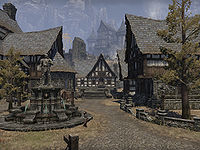
Architecture[edit]
Most of the cities in High Rock are built in the Breton style, with houses built primarily from stone, strong walls and high towers with the spires. Orcish architecture can be found in Wrothgar. Additionally, a number of Ayleid and Dwemer ruins can be found in High Rock.[6]
Flora[edit]
Northwest Tamriel is home to many herbs that can be used in healing poultices and medicinal broths, such Moth Nettles, Clickweed, Red Coldberry Leaves, Yellow Clover, and Brandelion used in tinctures, and Stendarr's Wort, Comfrey, Valendula, Blue Yarrow, Gemweed, and Healer's Purse in herbal poultices.[111]
Glenumbra is characterized by its wet climate, which the southern forests of Daenia and the central swamps of the Cambray Hills thrive in. Birch trees sprout cheerfully in Daenia's lush woodlands, and dot the landscape around the King's Guard Mountains.[112][113] Lily pads float in the water of Hag Fen, while moss leeches moisture off the surface of rocks. Pine and cypress trees also flourish (and rot) in the swamps of the Cambray Hills.[114]
Rolling hills, rushing rivers and a mild climate make up Stormhaven, the heart of High Rock. Sparse woodlands have been cut back to make way for farms, wildflowers inhabit the rolling hills, and cattails are nestled at the river's edge. Tall, strong trees dot the highlands.[115] Oak trees are common in the region.[116]
Rivenspire is a mountainous and largely dry region characterized by imposing mountains, flinty crags and howling winds. The soil is poor in most of central and southern Rivenspire, making lush plant life scarce.[117] Aspen trees manage to thrive throughout the region, but especially in Westmark Moor.[118] Boralis defines the region's coastline, which is separated from Eyebright Feld to the southwest by the high, jagged peaks around the Doomcrag. Central Rivenspire is populated by gnarled, ashen trees and yellow grass. The region's hardy aspens sprout on the slopes and cliffs of Rivenspire's mountains. Thin shrubs and trees with sparse leaves populate the rugged, rocky region of Eyebright Feld.[119]
The regions north of the Bangkorai Garrison include Mournoth and Ephesus. The highlands of Mournoth are lush, green, and populated by juniper trees and Spriggans.[120] The forest thrives from Halcyon Lake all the way down the Bjoulsae River.[121] Clean, clear water runs throughout the region. The forests of Bangkorai are kept tame by a figure known to the people of Evermore as the Viridian Sentinel, and though subdued, the bulk of the region's densest forestry is confined to the Viridian Woods.[122] Ephesus is comparably small, forming the strip of land between Mournoth's subdued wild and the dusty mountains south of the Bangkorai Garrison.[123] Flowering yucca plants inhabit the Fallen Wastes of southern Bangkorai.[124]
Fauna[edit]
Many various creatures inhabit High Rock, among them wolves, bears, nereids, harpies, crocodiles and spriggans. In Wrothgar, Echateres, Riekr, and even Horkers can be found.[6] In the Western Reach portion of High Rock, Rays and Floaters can be found.[125]
Notable Places[edit]
- Adamantine Tower
- Located on Balfiera Island, this spire is the oldest structure in existence. The estimate of the date of its construction marks the beginning of history.
- Bangkorai Garrison
- A large defensive fortification on the border with Hammerfell.
- Cath Bedraud
- A large cemetery in northern Glenumbra.
- Camlorn
- The main city of the state of High Rock of the same name, located in northern Glenumbra.
- Crypt of Hearts
- An infamous dungeon located in southeastern Rivenspire.
- Daggerfall
- The main city of the state of High Rock of the same name, located in southern Glenumbra, south of Camlorn.
- Doomcrag
- An ancient Ayleid tower, destroyed in 2E 582.
- Evermore
- The main city of the state of High Rock of the same name, located in northern Bangkorai, near the eastern border to Hammerfell.
- Farrun
- A city on the north shore of High Rock.
- Glenumbra Moors
- A site of the ancient battle between the Direnni and the Alessian Horde.
- Jehanna
- A city in the northern area of High Rock, near the border to Skyrim.
- Northpoint
- The main city of the state of High Rock of the same name, in northern Rivenspire.
- Orsinium
- The newly autonomous province of Orcs, led by Gortwog.
- Shornhelm
- A city in central Rivenspire.
- Wayrest
- The main city of the state of High Rock of the same name, located in southern Stormhaven.
Gallery[edit]
Maps[edit]
See Also[edit]
- For game-specific information see the Daggerfall and Shadowkey articles.
References[edit]
- ^ Pocket Guide to the Empire, 1st Edition: High Rock — Imperial Geographical Society, 2E 864
- ^ a b c d e f g h i j k Pocket Guide to the Empire, 3rd Edition: The Sons and Daughter of the Direnni West: High Rock — Imperial Geographical Society, 3E 432
- ^ Creatures in Daggerfall
- ^ Blackheart Haven's appearance in ESO
- ^ The Elder Scrolls: The Official Survival Guide to Tamriel — Tori Schafer
- ^ a b c d e f g h Events of ESO
- ^ Visitor's Guide to High Isle — Dame Emisse Fairwind
- ^ The Warp in the West — Ulvius Tero
- ^ The Glenmoril Wyrd — Lady Cinnabar of Taneth
- ^ a b c d The Improved Emperor's Guide to Tamriel: High Rock — Flaccus Terentius, 2E 581
- ^ Holidays in Daggerfall
- ^ Orsinium Guide: The Basics
- ^ Before the Ages of Man — Aicantar of Shimerene
- ^ The War of Betony — Vulper Newgate, 3E 404
- ^ Subtropical Cyrodiil: A Speculation — Lady Cinnabar of Taneth
- ^ a b Pocket Guide to the Empire, 3rd Edition: All the Eras of Man, A Comprehensive History of our History — Imperial Geographical Society, 3E 432
- ^ a b c d Loremaster's Archive - Tamriel's Dungeons — Dhulef
- ^ a b c d Modern Day Bretons: Man or Mer? — Vastyr Historian Filibert Beauchamp
- ^ a b c Frontier, Conquest — University of Gwylim Press, 3E 344
- ^ a b c d e f g Pocket Guide to the Empire, 1st Edition: High Rock — Imperial Geographical Society, 2E 864
- ^ a b c Loremaster's Archive - The Druid Circles of Galen — Laurel of the Stonelore
- ^ a b c d e f g h i j k Wyrd and Druid — Archdruid Barnabe's Discourse with Mainlanders, 2E 553
- ^ Meet the Character - Sir Stefan Mornard — Knight Commander Jourvel
- ^ Druid Audrine's dialogue in ESO: High Isle
- ^ Breton Race Description in Arena
- ^ High Isle Preview—The Zone from the official ESO website
- ^ a b c d Exodus of the Druids — Druid Laurel of the Stonelore Circle
- ^ a b c A History of Daggerfall — Odiva Gallwood
- ^ Nedic Hex Totem codex entries in ESO: Greymoor
- ^ Before the Ages of Man — Aicantar of Shimerene
- ^ a b Once — Beredalmo the Signifier
- ^ Bailiff Erator's dialogue in ESO: Summerset
- ^ a b c d e f g h i The Bretons: Mongrels or Paragons? — Phrastus of Elinhir
- ^ Draoife Storystone codex entries in ESO: High Isle
- ^ Legacy of the Bretons — Stefan Mornard
- ^ Druid Farel's dialogue in ESO: High Isle
- ^ a b c d e f Druid Ryvana's dialogue in ESO: High Isle
- ^ a b c Loremaster's Archive - Bretons & High Isle — Lady Arabelle
- ^ Wyress Demara and Wyress Linnae's dialogue in ESO
- ^ a b Wyress Matilde's dialogue during Sojourn of the Druid King in ESO: Firesong
- ^ a b Sir Stefan Mornard's dialogue in ESO: Firesong
- ^ Druid Peeska's dialogue in ESO: High Isle
- ^ High King Emeric's dialogue in ESO: Firesong
- ^ Manmer Coupled Idol codex entries in ESO: Greymoor
- ^ a b c d Systres History: Volume 1 — Trilam Heladren, Associate Dean of Eltheric History, University of Gwylim
- ^ a b Druid King Kasorayn's dialogue in ESO: Firesong
- ^ a b c The Daggerfall Chronicles — Ronald Wartow
- ^ Rislav The Righteous — Sinjin
- ^ a b c d A Life of Strife and Struggle — King Laloriaran Dynar
- ^ Tower of Adamant — Hrerm House-builder, Bards College, Solitude
- ^ a b Rislav The Righteous — Sinjin
- ^ Alana Relin and Commander Parmion's dialogue during A Step Back in Time in ESO
- ^ The Last King of the Ayleids — Herminia Cinna
- ^ Day of Release information in Daggerfall
- ^ The Battle of Glenumbria Moors
- ^ Lady Clarisse Laurent Answers Your Questions — Lady Clarisse Laurent and Stibbons
- ^ The Horse-Folk of Silverhoof — Doctor Nabeth al-Gilane, Khefrem Academy of Yokudan Heritage
- ^ a b Wayrest, Jewel of the Bay — Sathyr Longleat
- ^ The Viridian Sentinel
- ^ Ring of the Pale Order codex entries in ESO: Markarth
- ^ Varieties of Faith... — Brother Mikhael Karkuxor of the Imperial College
- ^ The Great Siege of Orsinium
- ^ a b c d Pocket Guide to the Empire, 1st Edition: The Wild Regions — Imperial Geographical Society, 2E 864
- ^ The Mirror — Berdier Wreans
- ^ Pocket Guide to the Empire, 3rd Edition: Orsinium — Imperial Geographical Society, 3E 432
- ^ The Ashes of Our Fathers quest in ESO: Orsinium
- ^ From The Memory Stone of Makela Leki — Makela Leki
- ^ a b Tusks of the Orc-Father codex entries in ESO: Greymoor
- ^ a b Bangkorai, Shield of High Rock — King Eamond
- ^ Secession Stamp Block codex entries in ESO: Greymoor
- ^ Noble Knight's Rest codex entries in ESO: Greymoor
- ^ a b c d e Pocket Guide to the Empire, 1st Edition: Cyrodiil — Imperial Geographical Society, 2E 864
- ^ Legacy of the Dragonguard — Kiasa-Veda, the Chronicler of Blades
- ^ Maiko K'Elmar's dialogue in Redguard
- ^ 2920, The Last Year of the First Era — Carlovac Townway
- ^ a b High King Emeric Answers Your Questions — High King Emeric
- ^ Atlas of Dragons — Brother Mathnan
- ^ Purifier's Journal — Purifier Cyrus
- ^ Crafting Motif 8: Orc Style — Doctor Alfidia Lupus
- ^ Frostbreak Fortress loading screen in ESO: Orsinium
- ^ The Royal House of King Eamond — Seneschal Derric Andras of Castle Evermore
- ^ a b The Fury of King Ranser — Wafimeles Masteret (Lorekeeper)
- ^ Guide to the Daggerfall Covenant
- ^ Orcs of Skyrim — Thora Far-Wanderer
- ^ Marisette's dialogue in ESO
- ^ Gerard Althen's dialogue in ESO
- ^ a b Triumphs of a Monarch — His Majesty King Emeric
- ^ a b True Heirs of the Empire — Erystera Ligen
- ^ Guide to the Daggerfall Covenant
- ^ Orcs? Could Be Worse
- ^ Orcs: The Vermin Among Us — Absolon Sorick
- ^ A Warning to the Aldmeri Dominion — Erystera Ligen
- ^ Battle of Sancre Tor
- ^ The Arcturian Heresy — The Underking, Ysmir Kingmaker
- ^ Corpse Preparation
- ^ Krisandra's dialogue in Redguard
- ^ a b Death cutscene in Daggerfall
- ^ a b Archdruid Orlaith's dialogue in ESO: Firesong
- ^ a b Druid Laurel's dialogue in ESO: Firesong
- ^ Breton exclamations in Arena
- ^ Breton exclamations in Daggerfall
- ^ a b c The Fall of the Usurper — Palaux Illthre
- ^ Etiquette With Rulers — Erystera Ligen
- ^ Map of Iliac Bay – The Elder Scrolls II: Daggerfall
- ^ The Warp in the West — Ulvius Tero
- ^ Lord of Souls — Greg Keyes
- ^ The Great War — Legate Justianus Quintius
- ^ a b Episode 2: The Corsair Conspiracy quest in The Fall of the Dark Brotherhood in Legends
- ^ Cicero's Journal - Volume 2 — Cicero
- ^ Dialogue between Ulfric Stormcloak and Galmar Stone-Fist in Skyrim
- ^ Healing Herbs of Northwest Tamriel — Ulnil Tildarin
- ^ Flora in Daenia within ESO, also identified by Rohzika's stock for the region
- ^ Flora within King's Guard in ESO, also identified by Rohzika's stock for the region
- ^ Flora within the Cambray Hills in ESO, also identified by Rohzika's stock for the region
- ^ Appearance of Stormhaven in ESO
- ^ Flora in Stormhaven within ESO, also identified by Rohzika's stock for the region
- ^ Rivenspire's appearance in ESO
- ^ Flora located within Rivenspire, which is identified in Rohzika's stock for the region
- ^ Eyebright Feld's appearance in ESO
- ^ Appearance of Spriggans in Jackdaw Cove and the Viridian Woods in ESO
- ^ Flora within Mournoth in ESO, also identified by Rohzika's stock for the region
- ^ Wyress Demara's dialogue during The Will of the Woods in ESO
- ^ Appearance of Ephesus in ESO
- ^ Flora within the Fallen Wastes in ESO, also identified by Rohzika's stock for the region
- ^ Shadowkey Creatures
Note: The following references are considered to be unofficial sources. They are included to round off this article and may not be authoritative or conclusive.
- ^ a b c Lawrence Schick and Phrastus on Altmer Culture
- ^ Leamon Tuttle's Posts
- ^ How Druids tie into the Breton Legacy section in Firesong DLC & Update 36 Preview
- ^ Xanathar's Library Archive/History
- ^ Twitch Stream of ESO Live Legacy of the Bretons Autumn Event, time stamp 59:10-59:26
- ^ Youtube Stream of Firesong DLC Guided Tour with the Developers, time stamp 25:33-26:08
- ^ The Dragon's Eyrie/Daggerfall
|
||||||||||||||||||||

